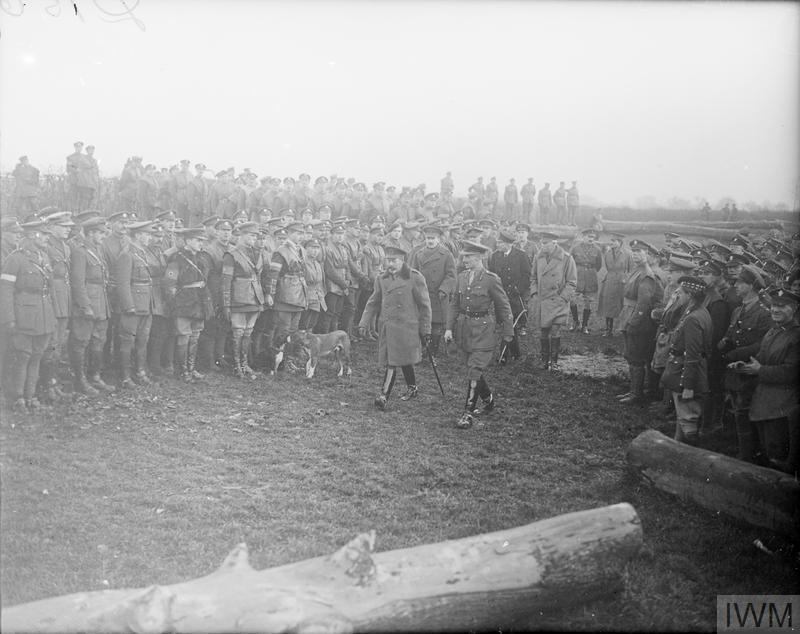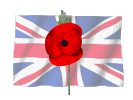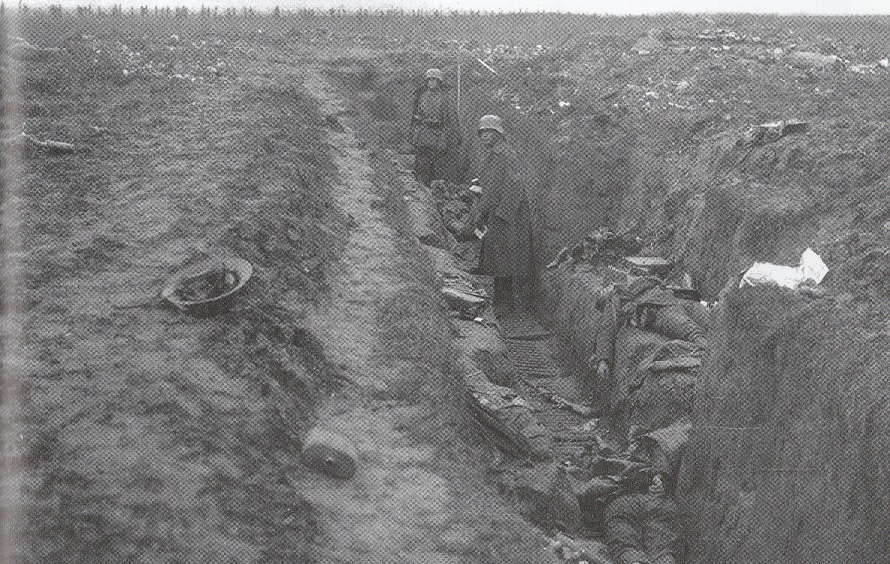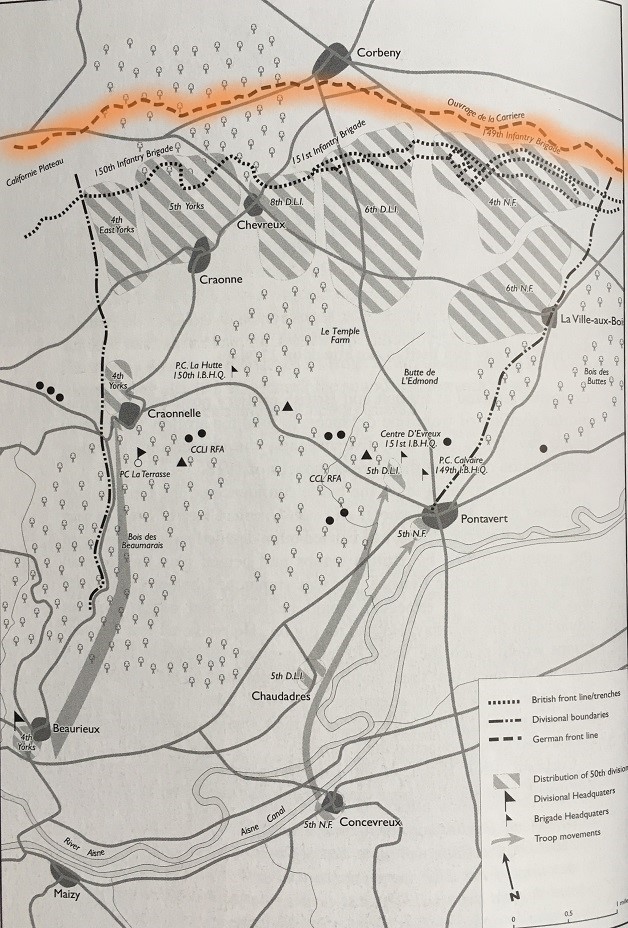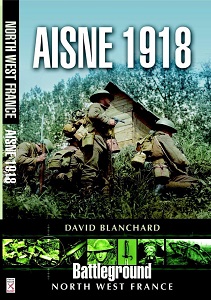7 Field Company 1918 War Diary Page Two
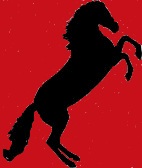

7 November: The company marched to Noyelles.
8 November: Marched to Monceau St Waast. It was night when we got there and received an order from the C.R.E. to reconnoitre and report on a crossroads somewhere ahead where a crater had been blown. I set out in the dark on a long ride, armed with an electric torch and a measuring tape. Having measured the crater and ascertamed the damage, I got back to Monceau in .the small hours.
.At Sassegnies there was a pontoon bndge someone had put over the river. The poor fellows thought that if they double-decked the roadway, it would make the bndge passable for 60-pounders. Of course the first one that went over went through, and its nose was sticking up sadly out of the water. I believe some men were drowned too.
Life is very exhausting at the rate we are going now, though I am enjoying it. The worst of moving warfare is that one has to do a long march every day, and the fighting and working are thrown in on top as extras! But the Boche has gone so far and so fast this time, that we have completely lost touch with him. We have such enormous long road communications behind us that we are held up for supplies and we just cannot keep up with him.
9 November: We marched from Monceu to St Remy Chaussee -St Aubin -Mt Dourlers -La Savate and to billets in Sars Poteries.
The first troops to enter Sars Poteries, accompanied by our ·advanced billeting party, had a tremendous reception.
Rimbod went with our billeting party, and was the first man in French uniform they had seen. He was kissed by every woman in the town! Everybody here is hugely enthusiastic . People constantly stop us to present flowers, or to compel us to come in and drink coffee.
The division seems to have completely reached the end of its tether, as far as supplies are concerned. Most of the artillery Divisional Ammunition Column has been put on to bringing up rations instead of shells.
There is now a great scheme for forming a single brigade to carry on the pursuit, and to put all the divisional transport including the D. A. C. at their disposal for supplies. I am to command the Royal Engineers with this column of pursuit, with the massed bridging equipment of all three field companies.
We shall accompany the advanced guard, of course, and it should be quite exciting, if only we can overtake Br'er Boche. I always have looked forward to a chance to bring my pontoons into action at a gallop and slap down a bridge under enemy fire! .
The infantry are having a hard time marching, and so are our own sappers, who have to work as well.
Notice taken from 7th Field Company Orders dated 9th November.
On the present muddy roads, all mounted ranks should take great care to avoid as much as possible splashing or hustling dismounted troops and civilians on foot.
Mounted men should not trot past troops, but make their horses walk quietly. ·
Signed J. B. Glubb,
Captain R. E.
10 November: The brigade of pursuit scheme is still in the air. At Sars Poteries station, there was a large accumulation of German stores, vehicle parks and equipment. I found a whole stack of cavalry lances, complete with red and white pennants, and took one away as a souvenir. The Boche lances are hollow steel, ours are bamboo. There were also some British wagons marked with the 25th Divisional sign. These must have been captured by the Boche in their May offensive in the Reims sector, where the 25th was one of the divisions involved. There was also a park of German guns, with the words, ultima ratio regis - the king's last argument - cast in the metal above the breach.
The company is fairly comfortably installed in a big farm and barns, but the horses are out in the open on picket line in a field.
11 November: Bulk forage such as hay has been almost non existent lately, owing to difficulties of transport. This morning we visited a deserted farm nearby, where there was a loft full of hay which we commandeered. As I was standing below, watching the drivers throwing the hay out of the loft window , a mounted orderly rode up, and told us that the war was over. A dreadful blow! I was just beginning to enjoy it, and this will finish my dreams of the dashing column of pursuit. Raining as usual.
11 November - 5 December: Alas, the war is over, at the moment when it was beginning to be exciting and enjoyable, after all these years. At first we got orders to rub up, inspect boots and clothing and get ready, with a view to a triumphal march into Germany. But soon that hope was destroyed also.
Notice in 7th Field Company Daily Orders.
In a recent official statement, the following numbers of prisoners captured since 1January, 1918, were given.
Captured by the British Army200,000
Captured by the French140,000
Captured by the Americans 50,000
Captured by the Belgians 50,000
J. B. Glubb
Captain R. E.
During this period, as the war was over, I paid a visit to Dad. He sent his car to fetch me. While with him, we did some sightseeing, and went to Lille, Courtrai, Ghent, Bruges and also to Zeebrugge. At the latter place, we were able to see very vividly how the British naval attack on the submarine base had taken place. It is almost incredible how our ships sailed straight into the port in the teeth of modern artillery and machine gun fire. The scrapes of the grappling hooks of Vindictive could be clearly seen on the parapet of the mole. The ships were still half visible, sunk in the mouth of the canal, to prevent the German submarines using it.
The towns which had been behind the Boche line all the war struck me as being perfectly luxurious. Ghent and Bruges were full of smart shops and well-dressed women. There were even chocolates and cakes and luxuries, which are absolutely unknown in England.
A very unfortunate incident occurred during our stay at Semousies, near Sars Poteries. C.Q.M.S. Church and his two storemen, Sappers Hamilton and Girdler, were sleeping in a cellar, which they used as a quarter master's store. They had a lighted charcoal brazier. During the night, a bale of clothing near the brazier caught fire and charred slowly, producing a dense smoke. This the sentry eventually noticed and gave the alarm. When we broke in, they were all three unconscious. Girdler was lying on the floor half way to the door, having obviously come round and struggled to reach the door before collapsing. We gave them artificial respiration and everything we could think of, but all three died without regaining consciousness.
Poor Church had been out since August 1914, and died just after the armistice. He had his leave warrant in his pocket, and his wife was expecting him at Dover two days later. Instead she got a letter to say he was dead.
Map: The Last Battle
4 November: 50th Division attacks on the line Robersart to Fontaine-au-Bois
5 November: Enemy disappeared. Company marched Fontaine-au-Bois--Carrefour de L'Hermitage--Hachette
6 November: Repaired demolished bridge at Noyelles
7 November: Company marched Hachette to Noyelles
8 November: Marched Noyelles--Monceau St Waast
9 November: Marched Monceau St Waast--St Remy Chausee--St Aubin--Douriers--La Savate--Sars Poteriers
11 November: End of the war
5 December: Marched Semousies--Taisnieres
20 December: Marched Taisnieres--Herbignies
20 December 1918- 20 February 1919: in Herbignies
21 February 1919 - 31 May 1919: Quesnoy
Right: Instructions from 50th Division
to 149th Inf Bde, 11 November 1918
Semousies
1-4 December 1918: Training and educational schemes. Fire in billet night 2/3, 3 O.R. killed, as shown on attached.
5 December 1918: Coy moved by march route to Taisnieres.
6-19 December 1918: Advance party to Orsinval on 16th. Training and educational classes. Advance party to Herbignies on 19th.
20 December 1918: Moved by march route to Herbignies - Villereau.
21-31 December 1918: Training and educational classes. 1 Officer and 43 O.R.s to Le Quesnoy on 23 Dec to repair roofs and billets of 149th Inf Bde. 6 O.R.s to Frasnoy on 27th to repair Mairie. Dec 21st commenced work with RA working party on demolished culvert near Gummegnies. Dec 29th 2 officers and 34 O.R.s, 5th R.I.R arrived at Gommegnies to work on demolished culvert.
5 December: Marched back from Semousies to Taisnieres.
20 December: Marched from Taisnieres to Herbignies, through the Foret de Mormal. The company is billeted in the village of Herbignies, which is undamaged by war. I have a room in the house of the Desmarets family, which is just inside the forest. Monsieur Desmarets is a forester, employed as such in the Foret de Mormal. Their cottage consists of the usual large kitchen and living room, with the stove in the centre. Several small bedrooms open out from the living room, of which I occupy one.
30 December: I have almost become a member of the Desmarets family, which consists of Monsieur and Madame and of two daughters, Gertrude and Gysele. We all spend the long winter evenings sitting round the stove in their parlour. The tell me stories of the long years they spent under German occupation.
Gertrude is a school teacher at the school in the next village, and has to walk several miles, there and back, to her work. Once or twice I drove her over in the mess cart and fetched her back from school. She is very serious and I think must have suffered.
The war really seems to be over this time. We have already received a circular on the subject of the demobilization of horses.
The Armistice and after - 11 November to 31 December 1918. By Capt H.A. Baker MC
The 11th of November found the 7th Company quartered at Semousies busily restoring communications in that neighbourhood, on that and succeeding days. Work was cancelled for the 12th November and 7 Company attended a ceremonial parade for medal presentations held by the G.O.C. 5Oth Division. The Company remained at Semousies until the 6th December, when it marched to Taisnieres and on the 20th to Herbignies, and remained there till the end of the year. During this time it continued to be employed on communications, improvements to billets, water supply, recreational training and education classes. Demobilization commenced with that of men with ‘’key trades’’, (miners, etc). Owing to a deplorable accident caused by fire, the deaths occurred on the 3rd December of T./C.Q.M.S., J.G. Church M.S.M. (who had served in the field with the Mounted Section throughout the war), Sapper S. Hamilton, Sapper A. Girdler. Space has not permitted much mention of the Mounted Section, but this record would be incomplete without referring to the very valuable work done by them throughout the war. Under Serjeants Armstrong, Church and Orchard, the Section never once failed to produce the goods, often under strenuous circumstances, the difficulties of which, are not always fully realised by the dismounted sections. Throughout the war the horses and general turnout were kept to a very high standard and always created a good impression on the march and at the occasional ‘’horse shows’’ that were held during periods of rest.
Right: IWM photo titled:
The King's visit to the Fourth Army (50th, 46th, 1st, 2nd and 4th Divisions in the Maubeuge - Avesnes - Landrecies area). King George V with Major-General Henry Cholmondeley Jackson, the Commander of the 50th Division, inspecting the 149th Brigade...
7 Field Company were on this parade and were the third unit from the right facing west. They could be on the left of this photo.
Company casualties, reinforcements, discharges and appointments for November 1918
Below: Company Returns for December 1918. Reversions and Appointments & Transfers to England for disposal
Comments to - georgecowie103@yahoo.co.uk
D.O.W - Died of Wound
K.I.A - Killed in Action
P.O.W - Died in captivity, most likely from the Spanish Flu that was at the time, pandemic and killed millions of people world wide. Other causes of death could be from the effects of gas that they were exposed to prior to been taken prisoner and the meager and not very nourishing food rations caused by severe shortages the Germans were experiencing.
FLU - Spanish Flu, four men in the Company died of this flu
11, P.O.W.s are buried in Germany
1, P.O.W. buried in Poznan, Poland, which was part of Germany at that time.
12, P.O.W.s are buried in France
The Black Horse Trail 2018, visit the site where King George V inspected men of the 50 Division
The graves of Spr Girdler, CQMS Church and Spr Hamilton at Dourlers Communal Cemetery Extension, France
The Final Advance Epehy to Semousies (1st October-11 November) By Capt H.A. Baker MC
The general line of attack and advance of the 50th Division was from Epehy (15 mile south-west of Bapaume), through Le Catelet (on St Quentin canal), St Benin (on the River Selle 2 mile south of le Cateau), Landrecies (on Sambre canal), Marvilles(on river de Tarsy) to Semousies (3 mile north of Avesnes and 8 mile south of Maubeuge)- a total distance of 50 miles. This line of advance crossed at right angles the St Quintin and Sambre Canal systems and their numerous feeders running from south to north. The Germans in their retreat destroyed many bridges and railway viaducts over roads, in addition to making large road craters, thus rendering pursuit difficult and throwing an immense strain on the British engineers, on whose capacity to restore communications depended in great measure the success of the operations. The forcing of the passage of the St Quentin Canal in the neighbourhood of Vendhuille was the first task confronting the Division and was successfully carried out on the 5th October. From the 1st to the 5th October the Company was in dugouts east of Epehy. Reconnaissances of the canal were carried out and bridging stores collected in Epehy. During the attack on the 5th the Company constructed two footbridges and one medium pontoon bridge over the canal, with the loss of two sappers wounded. On the 6th the Company moved to Vendhuille and between the 6th and 10th repaired the Vendhuille- Le Catelet road and constructed a bridge to carry all natures of traffic over the River l’ Escaut in Le Catelet. On the 10th the Company marched to Clary (10 mile) and on the 12th to Le Trou-au- Soldat, carrying out reconnaissances of the forward area on the 13th with view to passage of the River Selle, and constructed a bridge for horse transport west of St Benin on the 14th. On the 17th a general attack by the XIII Corps took place, the 50th Division forcing the passage of the River Selle about St Benin. 20 infantry footbridges were erected over the River Selle, all field companies being employed on their construction. On the 18th the Company constructed a pontoon bridge west of St Benin, and on the 19th was employed on clearing the St Benin - Le Cateau road, where blocked by the demolition of a large railway viaduct. The 50th Division was relieved this day by the 25th Division till the 30th, during which period its field companies continued to assist the 25th Division in clearing roads east from Le Cateau, the 7th Company clearing the block caused by the demolition of the railway viaduct a quarter of a mile north-west of Bazuel. The 1st to the 4th November was spent in making preparations for the forcing of the Sambre Canal, the Company preparing Le fayt farm for occupation as Brigade H.Q., taping out assembly positions and cutting gaps in the hedges for the 149th Brigade immediately east of Fontaine-au-Bois, repairing and reconnoitering roads etc. On 2nd November No 2 Section moved to Bousies to work with the 50th Division artillery and prepared tracks to enable the guns to advance. The German resistance was now weakening considerably. On the 4th November the Coy moved from Benin to Fontaine (6 mile), on the 5th repaired the Fontaine - Landrecies road, and on the 6th moved from Fontaine to Hatchette (5 mile) on the southern edge of Foret de Mormal and constructed a length of Corduroy road with POW labour and a service trestle bridge of three bays over the River Grand-Helpe at Noyelles, to which latter place Company HQ moved (4 mile). On the 7th work was carried out on communications generally and mines searched for indicated by mines. The Company moved on the 8th from Noyelles to Monceau (4 mile), and on the 9th to Dompierre (4 mile) to form part of a mobile column under the G.O.C 150th Brigade. On the 10th it moved from near Dompierre to Semousies (5 mile), and with three companies of infantry cleared blocks on the Maubeuge - Avesnes and other roads. Work on a bridge over the River de Tarsy was commenced on this day. Battle casualties during the operations 1st October to the 11 November were two sappers killed on the 27 October and two wounded. A severe outbreak of Spanish influenza in the latter half of October caused large sickness casualties, especially amongst the Mounted Section. Of 50 admissions to an isolated hospital 30 were drivers and for a fortnight the horses and wagons were almost entirely driven by dismounted men. The epidemic hampered operations considerably and increased the heavy strain on the short handed engineer companies engaged on numerous works of tactical importance. Lieut Rebbeck, M.C. died of influenza on the 4th November. Drivers, L. Light, P. Arnold, and sapper W.F.Bett also died of Influenza during the early days of the same month.
St Benin
1 November 1918: Preparing Le Fayte Farm for Bde HQ
2 November: Preparing Le Fayte Farm for Bde HQ, No 2 Section moved to Bousies to be attached to 50th Div Artillery
3 November: Taping out assembly position and cutting gaps in hedges for 149 Inf Bde in front of Fontaine au Bois, bridging equipment handed over to 447th Coy at Pommereuil
4 November: Repairing roads near Fontaine au Bois, fixing notice boards between red line and old front line, reconnoitring roads, searching for mine at G16.c. Company moved from St Benin to Fontaine
5 November: Repair road Landreceis to B26.c.2.0 Sht 57a
6 November: Coy moved from Fontaine to Hachette. Started work on Cadway road with P of W labour at diversion to bridge at B27 central Sh 57a. Built service Trestle bridge over R Grande Helpi at Noyelles C25.d.2.7.
7 November: Coy moved from Hachette to Noyelles. Bridged gap at C25.d.2.8, improved approaches to bridge at C.25.2.7. Searching for mines at 3 points as showed by civilians, erecting notice boards.
8 November: Coy less 1 section moved from Noyelles to Monceau. Putting wooden bin and clearing road blocked by demolished bridge.
9 November: Coy less 1 Section moved from Monceau to Sars Poteries to form part of a mobile column under command G.O.C. 150 Inf Bde.
10 November: Started work on bridge at F13.c.90.25. Started work on filling craters at Le Savate. Section 2 attached for operations to 50th Div Artillery moved from Sassignes to Semousies and rejoined Company. Coy moved from Sars Poteries to Semousies
11 November: Cleared roads part of Maubeuge - Avesnes and Mont Dourlers - Sars Poteries with 3 Coys Infantry. Completed bridge at F13.90.25. Worked on La Savater crater
12 November: Started work wooden bin culvert E13.c.7.0. Sht 57a
13-17 November: Work on wooded bin culvert ------------"-------------
18 November: Do. Sent party for demolitions of salvage to 149 Inf Bde.
19 November: Wooden bin culvert E13.c.7.0 completed.
19-30 November: Training, educational work and improving billets.
1 November 1918 The front line now runs along the western edge of the Foret de Mormal, the 50th divisional front being from Fontaine-au-Bois to Robersart. A very large operation for two or three armies is being prepared. The major has gone ·sick with some kind of influenza and has been evacuated. This gives me the chance of commanding the company during the coming battle. The front line consists of scattered posts of infantry, lying up in ditches and hedgerows through Les Grands Chenes, Robersart and
Fontaine-au-Bois.
The group of villages in our front line are in very close country, consisting of small orchards and gardens, enclosed by high banks and thick hedges. The front line is by no means easy to find, and the unwary are liable to walk through into the arms of the Boche. The troops for the attack are to come up to their jumping-off positions during the night previous to the dawn of Z day. Owing to the denseness of the country and the high strong hedges, it is feared that confusion may occur in the dark. We are, therefore, detailed to carry out the following work:
(a)To tape out a jumping-off line in front of our present front line posts, to enable our attacking troops to form up on a straight line before advancing against the enemy. The jumping-off line will be marked with a continuous white tracing tape. Most of our work has, of course, to be done at night, the actual taping of the jumping-off line may be quite tricky. But the thickness of the hedges gives us quite a lot of cover.
(b) To cut paths through the hedges, gardens, and other obstacles of which the village of Fontaine-au-Bois consists. The troops will be guided to the rear end of these paths, and follow them up, in order that all the assault troops may reach their deploying positions before Z hour, without noise or confusion.
(c) All these cleared paths leading forward are to be notice boarded with small boards painted in luminou s paint, giving the names of the battalions and an arrow indicating the route. The tanks will also move up just before dawn.
We are part of XIII Corps, of which the 25th Division is on our right, we, the 50th Division, in the centre and the 18th Division on our left. The 50th Division is to attack with the 149th Infantry Brigade on the right and 150th on left . The 151st Brigade will be in reserve. We, the 7th Field Company, are to accompany 149th Brigade, and are responsible for getting them correctly deployed on their jumping-off line before Z hour.
The infantry have been given three objectives, marked with coloured lines on their maps. We are to follow behind them clearing obstacles and re-opening the roads to allow horsed transport to come up behind us. When the second objective is taken, the 151st Infantry Brigade will pass through 149th and 150th, and will continue the advance. We are also told to detail one section of sappers to join the artillery at Z hour, and to assist them to get their guns forward quickly across country. For this purpose, Seels has with him some standard light artillery bridges loaded on a wagon, to get the field-guns over ditches and streams. He also has pack horses to move, his gear across the fields with the gunners, and one of our trestle wagons.
Our brigade will attack with the 3rd Royal Fusiliers on the right and the Scottish Horse on the left. The 2nd Royal Dublin Fusiliers will be in reserve. When the jumping-off line is taped, small notice boards will be laid on the ground saying, for example, Right of Scottish Horse, Left of 3rd Royal Fusiliers.
We do not yet know when Z day will be, but we expect it in two or three days. Meanwhile there is an immense amount of work to be done. We have to make and paint a great many little notice boards, with the initials of the regiments and an arrow painted on each, to be used to mark the tracks leading up to the front line. I have ordered all hand axes, hand saws and billhooks to be sharpened.
Then I have to meet the infantry battalion commanders, and inform them of details of all the signs, tapes and arrows we intend to use. We also had a little advanced practice in cutting through hedges in the dark on the night of 1 November at our farm billet at St Benin. On 2 November, we went up to- Fontaine-au-Bois and cut through some of the hedges at ground level, but without removing the brush wood.
Z day was first fixed for 3 November but has now been postponed to 4 November.
4 November: I was in Fontaine-au-Bois before dawn on Z day. Taping out the jumping-off line was quite exciting, as we were working in front of our own front line. There was a certain amount of desultory shooting, but the country was so thick with trees and hedges, that the Boche did not realize what was going on. Our infantry got deployed without any confusion. A certain amount of shelling came over into the village of Fontaine, and the infantry were held up for some time by machine-gun fire. But once the Boche front line was taken, resistance ceased and so did the shelling. Their gunners were doubtless only too busy trying to get their guns away before our infantry arrived. By 11.30 am. we had taken our second objective and were advancing with very little opposition anywhere.
The enemy has melted away before us like snow. Perhaps he will not stop till he gets back to Germany. As soon as the infantry had gone forward, roads were our chief immediate concern. Indeed so rapid have been our recent advances, that they will probably soon be our only concern. Railways are already left far behind, and after each advance so many of the roads had been demolished or blocked as almost completely to prevent our following up the enemy.
On the afternoon of Z day, 4 November, I carried out a long mounted reconnaissance through the Foret de Mormal. There were already no signs of troops anywhere, so rapid had been our advance, and very few casualties about. At a crossroads, there was a shell-hole in the middle of the road and a young German soldier lying on the edge of it. His helmet had rolled off, his face was snow white and a stream of blood flowed from the top of his head. He looked so young and innocent, scarcely over sixteen I should think. I am afraid the Boche army is in much the same state as ours, all children or old men.
The sapper's this afternoon worked on clearing the roads through Fontaine-au-Bois. The enemy has vanished without sign or news.
5 November: The company, less one section still with the gunners, marched today from Fontaine-au-Bois to Route de Landrecies - Carrefour d !'Hermitage - Hachette. The sappers came along splendidly, singing,
'Oh it's a lovely war. Form fours! Right turn!
How shall we spend all the money we earn? Oh, oh, oh, it's a lovely war!'
A new job arising during these advances is the signboarding of the roads. Dozens of signboards have to be painted before each advance, and fixed at all cross-roads as soon as captured. Otherwise, when penetrating new country, the columns of transport get lost and endless confusion results. It was raining in sheets when we got to Hachette, and parked the transport between the road and the river. We got into a bare but more or less undamaged house. All soaked
to the skin and very cold.
I was just thinking of something to eat, when an order came to reconnoitre and repair a destroyed bridge over a river at Noyelles. I rode off at once myself to have a look at it. It was a brick arch bridge over a small stream, but it was completely demolished. Still pouring with rain.
We overtook our leading infantry here, but they have completely lost touch with the enemy . Our own cavalry might have been useful here, but there do not seem to be any of them around, now they are wanted. Our infantry were just moving up into Noyelles, the leading files climbing down and across the debris of the ruined bridge in single file. They were, of course, all. like drowned rats, with their waterproof sheets hangmg shining over their shoulders.
Two Frenchmen were standing on the far side of the stream, helping our fellows to scramble up. Our boys were laughing, and all of them thanked the Frenchmen for giving them a hand. I heard one of the Frenchmen say to the other, 'Mon Dieu, mon ami, quelle difference apres les Boches!' These are the first civilian inhabitants whom we have found behind the Boche lines.
Back to Hachette after dark. Done to the world, soaking wet with a horrible backache. This moving warfare is very interesting but a bit strenuous.
6 November: Back to Noyelles with some sappers and the pontoon wagons. Completed a bridge during the day. We put a trestle bridge on a deviation, so as to leave the main road gap for the erection of a heavy bndge.
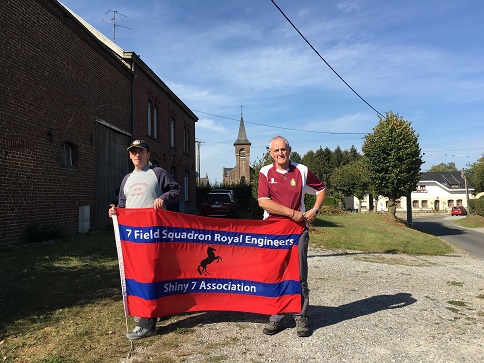
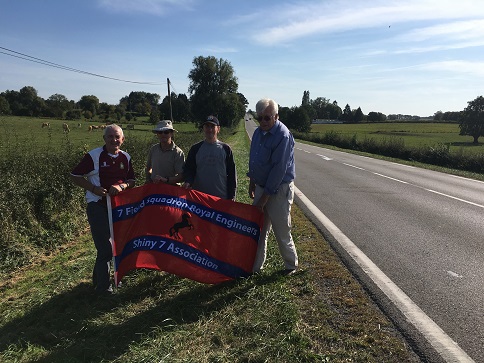
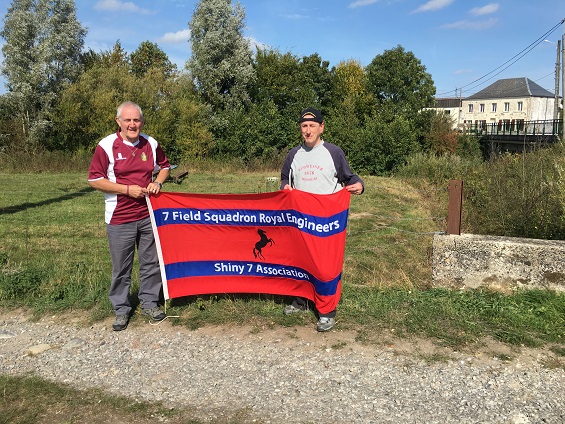
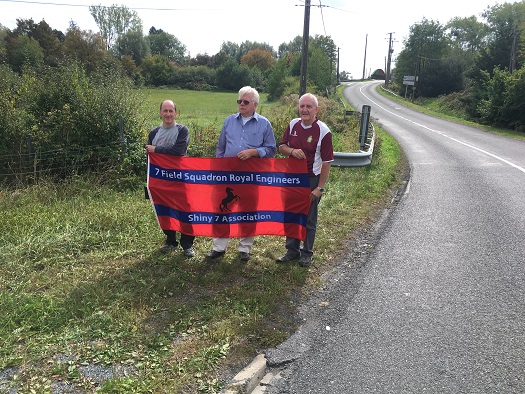
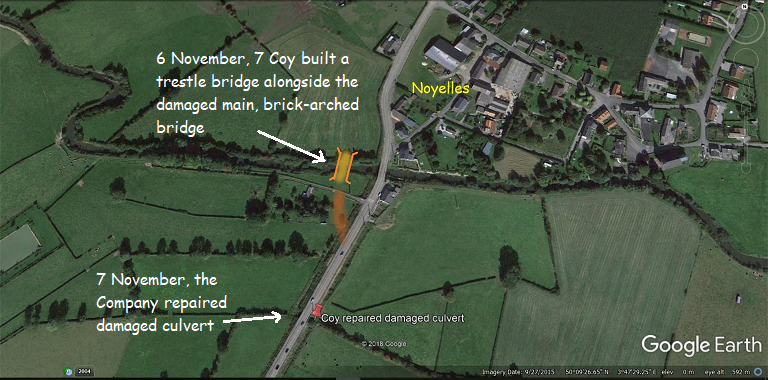
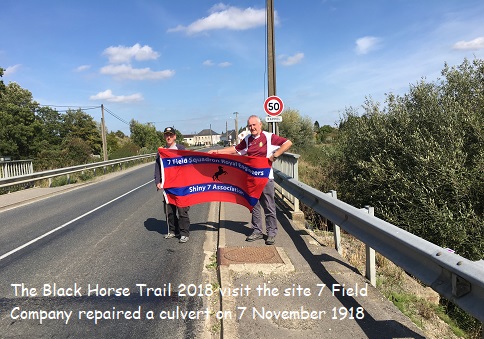
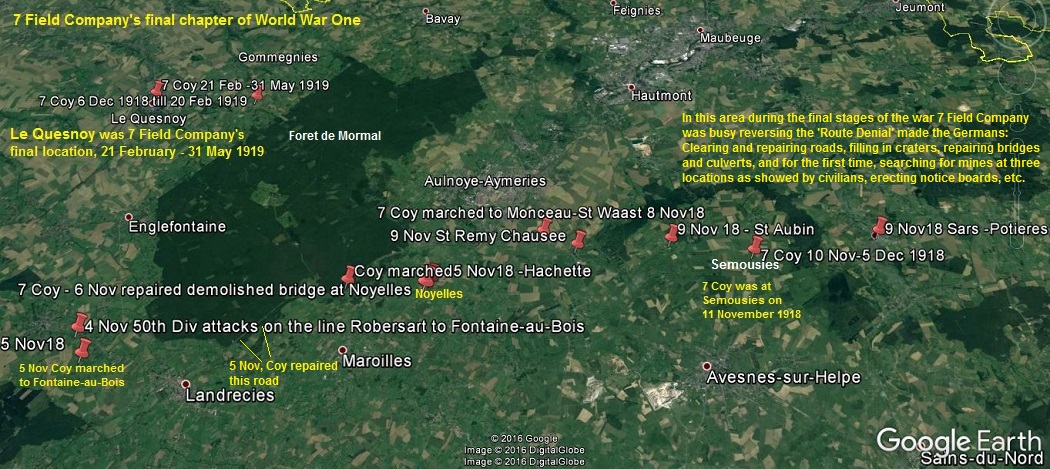
Brian and Brian stand on the site where 7 Field Company built a trestle bridge alongside the damaged original bridge 6 November 1918
7 Field Company bridge the River Helpe Majeure

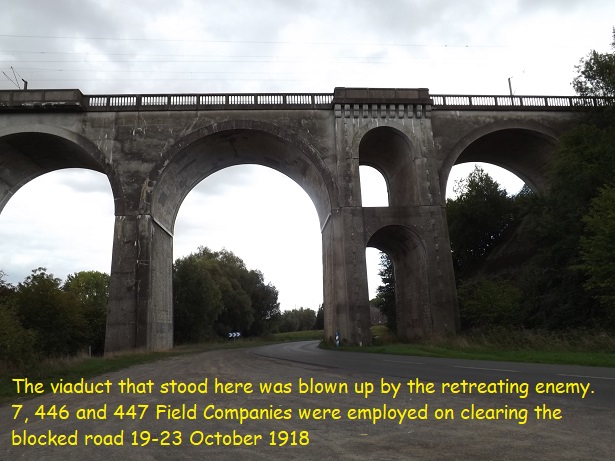
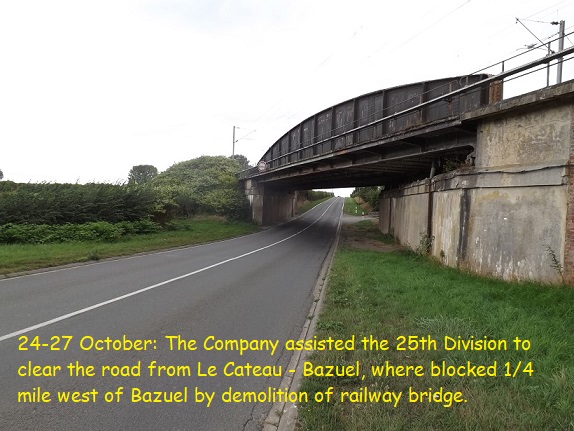
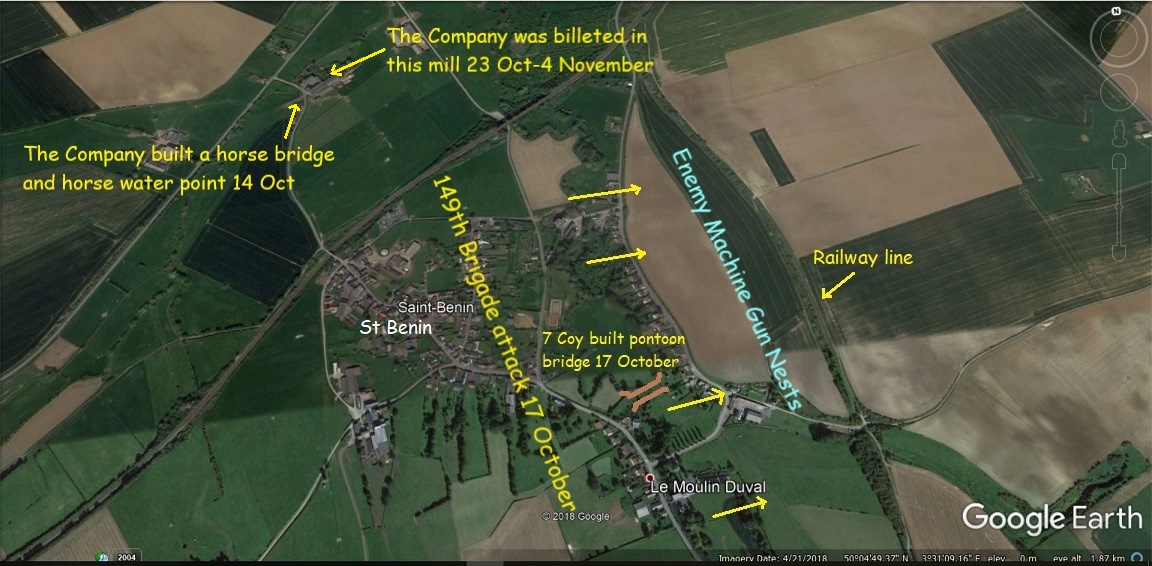
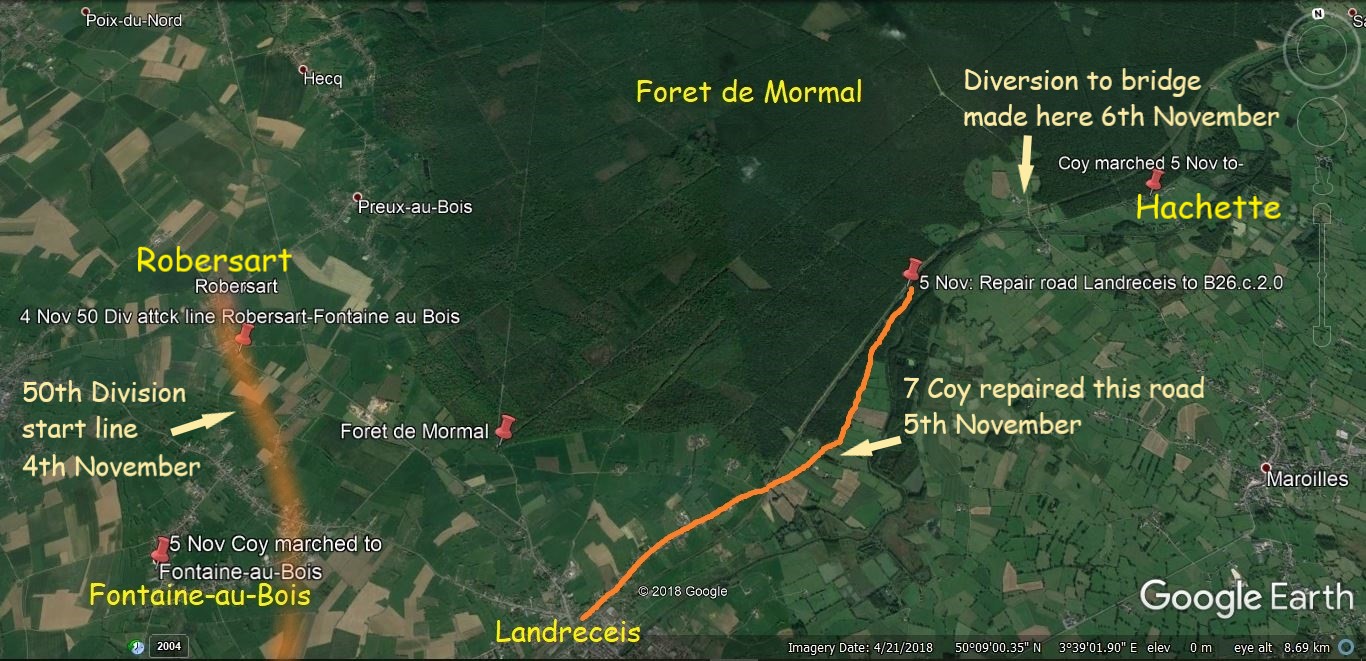
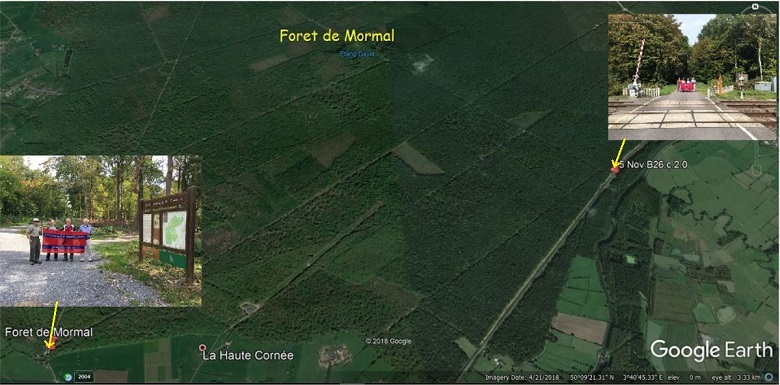
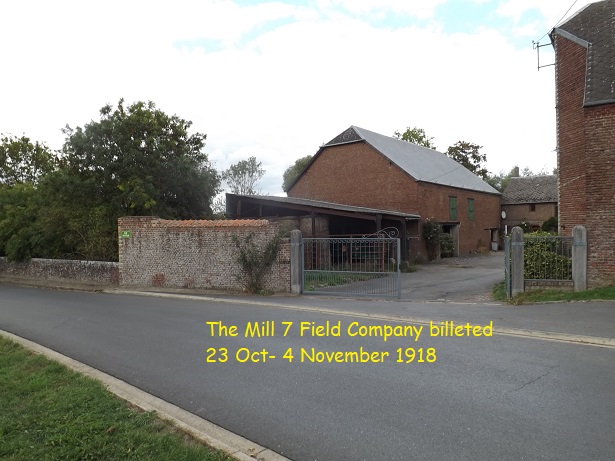
23 October: The crossing of the River Selle and the capture of the St Benin - St Souplet line having been successfully accomplished, we moved forward and occupied the farm outside St Benin. We followed the infantry on, in order to clear the roads through Basuel, where a heavy railway girder bridge had been blown down on the road.
On one occasion, I rode up at night to the Basuel area and rode Peter, a chestnut horse who had been in the company since before the war. Cantering back in the dark over the open ground between Basuel and St Benin, he suddenly fell head first into a large shell-hole. We turned a complete somersault and I foolishly let go the reins. Before I could get up, Peter scrambled to his feet and galloped off into the dark. Not only did we lose a very good old horse, but also he had on all my gear, saddle, white head rope, corps breast plate and brass rosettes!
I went into Le Cateau once or twice. It was not very much damaged. In a large house at the south end of the town, the Kaiser is supposed to have stayed in March 1918, when he came over to watch the great Boche offensive against the British on the Somme.
We were shelled once or twice in our farm at St Benin, as the enemy has not gone very far. On one occasion, something about the size of a 4.5-inch shell pitched against the back wall of the house, while we were having dinner, and made the deuce of a bang . We stood to our horses, but no more came. We built two bridges across the River Selle near St Benin. Standard bridges are now all the fashion. They are all ready made up at Corps or Army dumps, of steel joists which only require bolting up.
1-6 October 1918: Company in dug-outs in front of Epehy. Reconnaissance of St Quentin Canal in Vendhuile with a view to bridging. Stores for same purpose collected in Epehy.
On Oct 5th, infantry attacked. Company cooperating constructed two footbridges over canal and one pontoon bridge.
6-10 October: Company moved up to De La L'eau. Vendhuile-MacQuin Court-Le- Catelet road repaired. Bridge for all traffic constructed in Le Catelet over L'Escaut. On Oct 10th Company moved to neighbourhood of Clary.
11 October: Standing by at Clary.
12-14 October: Company marched to Le Trou au Soldat. Reconnaisance of forward area carried out.
14-19 October: Bridge for Horse transport constructed west of St Benin, and watering point at same place. Pontoon bridge put in across River Selle in front of St Benin.
19-23 October: whole Company clearing roadway blocked by demolition of railway viaduct, 1/4 mile N.W. of St Benin. On 23rd Company moved up to Mill. 1/2 mile due west of St Benin church
24-27 October: Assisting 25th Division to clear road from Le Cateau - Basuel, where blocked 1/4 mile west of Basuel by demolition of railway.
28-31 October: Company resting in Mill, west of St Benin. Company suffered very heavy casualties this month commencing about Oct 15th from "spanish" Influenze. About 50 men went sick to an isolation hospital, about 30 of there being drivers. For a fortnight, the horses and waggons were almost all driven by dismounted men.
2 October: Started at last. The major having gone up the line to loqk round and take over, I lead the company up to Epehy. We are back up, the line here, in the middle of the guns.
Marching up with the company, saw a pretty little exhibition. A Boche machine dived unexpectedly from the blue on to one of our kite-balloons. We could just hear the rat-tat-tat of his machine gun. The observers were out in their parachutes before you could say 'knife', and a second later the balloon burst into flames. The Boche then flattened out and flew at the next balloon; out popped .the two parachutists from it also, and the balloon burst into flames. A very neat little performance.
Having arrived at Epehy with the whole company, we were then told that the mounted portion should have been left behind, and they were sent back to Saulcourt. I followed them later and reached their camp at 9.30 pm.
3-5 October: Comfortable here in dugouts. The division is in the line. The Boche are holding a section of their great Hindenburg Line. Our particular front is in the village of
Vendhuille. Here the enemy is holding one side of the canal and we the other.
.We are expecting to attack soon, and immediately this is done, the company is to erect a bridge over the canal at Vendhuille. For this purpose, we have been reconnoitring the place where the bridge is to be. This is not easy to do as the Boche is on the far bank of the canal. I went up to Vendhuille at night and had a good look at the whole place. Things were fairly quiet.
We were quite busy on this job. We were first to fix some light footbridges in front of the infantry, when they assaulted across the canal. There was some excitement over the construction of these floating footbridges, which were made alternatively of cork, petrol cans or other improvised materials. Number 283 Army Troops Company R. E. were near us at Saulcourt, with one of the new Inglis bridges, packed on motor transport. Eventually, after the assault bndges, we put in our pontoon equipment on a deviation leaving the main road gap clear for 283 Company; subsequently to erect their heavy Inglis bridge .
6 October: The division attacked today and took Putney, Le Catelet, Gouy, and La Pannerie.
5-7 October: Working all day carrying up bridging material for the bridge at Vendhuille. We put in a pontoon bridge at Vendhmlle and Seels, with No 2 Section, put a bndge across at Le Catelet, to take up to six-inch guns. The Boche are now holding the Beaurevoir - Masnieres line. The company is at Dela l'Eau.
8 October: We attacked again today and took Aubencheul au-Bois, Villers-Oureaux and Guisancourt. The enemy is now expected to withdraw to the Valenciennes line. The army on our left, however, report heavy fighting still going on at Cambrai. Pontoon and trestle bridges erected at Vendhuille were dismantled today, heavy bridges having been erected. The pontoons have been loaded up to follow the infantry. They will be required in a day or two to cross the river at Le Cateau. .
The division is advancing north east approximately up the straight road from Estrees to Maretz, Reumont, and south east of Le Cateau. We hope thus to turn the flank of the enemy, who are still resisting at Le Cateau. I carried out a reconnaissance of the roads just behind our advancing infantry beyond the Masnieres-Beaurevoir line. As I was returning at dusk, I could see the villages on fire miles away ahead towards Maretz and Busigny. We did not know at the time the exact result of our attack, but I wrote in my report to the C.R.E. that the enemy seemed to be retiring right away, burning the villages.
9 October: We attacked again today and took Maretz, Clary, Bertry, Maurois, Honnechy, Reumont, Troisvilles.
10 October: Woken up at 3 a.m. by orders to march at 6 am. Dark and cold. Marched via Le Catelet, Guisancourt, Serain, Maretz and Bois de Gattigny . We occupied a large deserted factory at Clary. Very comfortable quarters and the horses under cover. The villages here are once more intact, or only very slightly damaged. /
The Boche seems to be very shaken. He seems to have been only delaying us from the 6 to 9 October. Once the Hindenburg Line went on 6 October, he probably decided to move back to his next position. On 9 October, he melted away and by the morning of 10 October was back holding a line St Souplet - St Benin, south of Le Cateau.
11 October: Our billets at Clary were too comfortable to last. The Chief Engineer, V Corps, came round and told us we were in his area . We seem to have lost our division!
12 October: Marched out of Clary via Maretz to Le Trou aux Soldats. A good billet here too. It is very delightful and comfortable being In undestroyed country. The mounted section is in an old German bakery. All the horses are under cover.
The Boche is holding a line through St Benin and St Souplet, two villages on a ridge. On our left, the 66th Division is in Le Cateau. We have relieved the 25th Division in front of St Benin and St Souplet. The 2nd American Army Corps is on our right, supported by the artillery of the Anzac Corps, the infantry of which is out resting.
Our front line is in the bottom of the valley of the River Selle, overlooked by the enemy on the St Benin - St Souplet ridge. An operation for the crossing of the River Selle is being planned. We are making up light infantry foot bndges, which the sappers are to run out in front of the assaulting infantry and throw down over the stream.
13-20 October: During this period, the wagons were employed on the road Le Trou aux Soldats through Busigny ad Honnechy. In front of the Honnechy cross-roads was in view of the enemy and could only be used at night. One of Pearcey's horses was wounded here one night. It was hit in the face. I asked the vet to try and save it-it was a beautiful chestnut -but it had to be shot in the end. I went up several times by day on foot to recce, and we selected a partially damaged farm near St Benin, which the company was to move up to directly after the attack. As Field Service Regulations state, 'time spent on reconnaissance is seldom wasted'. We are on something like open warfare here, with almost undamaged country and no trenches. The front line is merely a chain of little posts, dug in under hedges, at road corners etc.
On one occasion, I took some wagons up at night to the farm in front of St Benin, carrying timber and materials which would be required on the morning of the attack. It was rather rash, as the wagons were only a few hundred yards from the Boche front line, and they felt very conspicuous then the Very lights went up. But we got away with it all right. There is an old German engineer dump just south east of Honnechy, from which we take stores. The Boche likes to shell the Honnechy-Reumont area a bit.
It was just round here that the Battle of Le Cateau was fought in 1914. I think that Smith-Dorien 's corps was holding the open ground east of Reumont - Honnechy . Le Trou aux Soldats, our rear billet during these days, had quite a mixed population. Our old bakery building was also partially occupied by some American horse transport. They did not seem to be very well disciplined. They used to send their mules off to water on their own, the driver merely beating them across the rump, and shouting affectionately, 'Git on, ye God darned son of a b - !' They attracted the notice of their officer by shouting, 'Hi!'
The village also contained part of the 13th (I think) Hussars. Haig and the powers-that-be, being all cavalry men, are determined to use the cavalry someday. But they have never been any use yet, and are a cursed nuisance here and take up a lot of room. The officers affect something of elegance, but their horses look poor on the whole. Being all clipped, they suffer from the cold. I don't approve of clipping. If you take trouble to groom thoroughly, you should be able to avoid mange better that way. The cavalry might well be
re-christened 'the look-ons', as they were called at the Siege of Sebastopol.
The Australian gunners are covering the Yankees. Two Anzac officers I knew came in to see us. They say the Yanks are the slowest thing out. I have noticed the same myself. Most of them seem to be slow and simple country bumpkins, not at all what we expected. We imagined they would be too smart and clever for words.
The Anzacs live on the fat of the land, pinching the Yankees' equipment and rations. They told us the story of an American driver, who left his wagon and pair in the street while he went into a house. An Australian immediately mounted and drove them off and neither wagon nor horses were ever seen again. The Yankee could not figure it out at all, and was left scratching his head in the street.
Such American officers as I have met have been very quiet and modest, and anxious for information. Their troops are said to have fought very dashingly " but not always very
successfully, being very inexperienced. While we were at Vendhuille, they did an operation on our right, in the course of which they penetrated quite a distance, but made no arrangements for mopping up or for consolidation. As a result, they were cut off by a Boche counter-attack, and large numbers of them were taken prisoners.
'Booby traps' are now the order of the day. The Boche have mined many. of the houses and dugouts they left behind, so that our people move in comfortably, and then the place suddenly blows up. As a result, people are now rather suspicious of too comfortable a billet, until they have been passed by the sappers, who write up in chalk, 'Passed by such-and-such a company R.E. 'A delightful job, feeling around a deep German dugout to see if it is going to blow up. A delay-action mine has blown up the railway near Busigny.
The Boche are also very good at road demolitions. In addition to just destroying bridges, they have one or two other ideas, such as:
(a)Tunnelling into the side of a road embankment and blowing a great breach in it.
(b) Dropping an overhead bridge onto a road passing underneath it. This not only cuts the railway, but also blocks the road with hundreds of tons of twisted steel girders, very difficult to remove quickly. We front line engineers have no equipment to do this kind of thing. We can only make earth diversions, or build wooden trestles or pontoon bridges .
(c) Mining the crossroads in the middle of a village. Either the crater has to be filled, or deviations made by knocking down the houses. Either job takes time and being at a crossroads, the obstacle creates a maximum of delay.
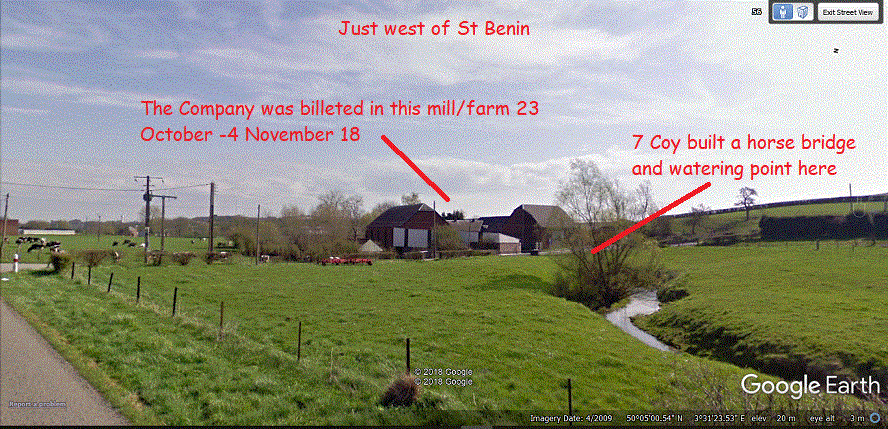
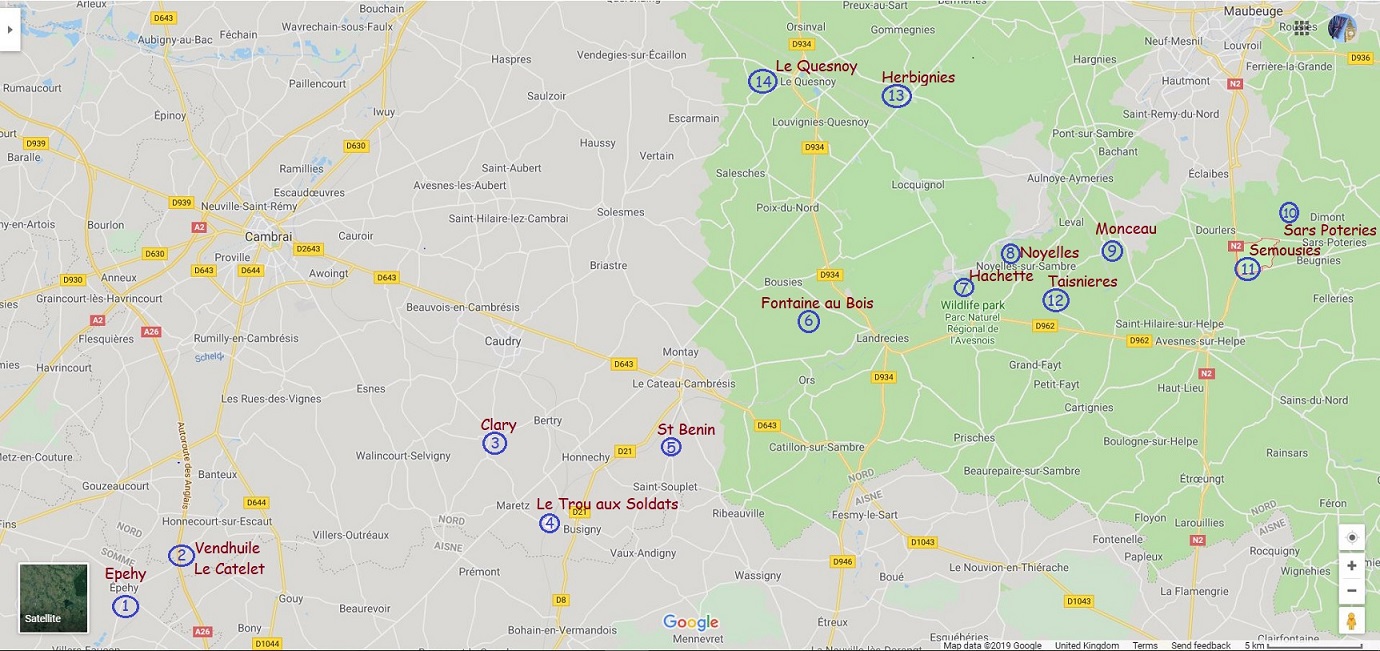
7 Field Company's Locations, 1st October 1918 - 31st May 1919
The Black Horse Trail 2018, stand on the site 7 Field Company with P.O.W. labour, put in a diversion to a bridge at Hatchette, 6 November 1918
The Black Horse Trail 2018, in Semousies
The Black Horse Trail 2018 outside the field King George V visited the 50th Division December 1918. The road is the Avesnes - Maubeuge road where the Company with infantry works parties repaired in December 1918
Video: 7 Field Company's Final Locations of World War One. Epehy to Semousies and the Winding Down of the Company in 1919.
https://youtu.be/iP5MmtaVvXw
The map on the right from the diary of Captain J.B.Glubb MC and later published in the book ''Into Battle'', by Lieutenant-General Sir John Bagot Glubb, KCB, CMG, DSO, OBE, MC, KStJ, KPM
Martin Eglise
1-16 September 1918: in Camp at Martin Eglise, Dieppe; Company employed on training and improvement of the camps in the neighbourhood. Pontooning was carried out both by day and night. Huts and horse standings were constructed.
16 September: On the 16th the Company entrained and proceeded to 3 Army Area, detraining at Bouquemaison and marching to billets in Brevillers.
17-25 September: At Brevillers- Training and refitting.
26 September: Moved from Brevillers to Esbart Farm near Agincourt. Transport by road. Dismounted personnel by bus.
27 September: Dismounted personnel at Esbart. Transport moved by road to Fricourt.
28 September: Dismounted personnel by bus to Nurlu. Transport moved by road to Nurlu.
29-30 September: At Nurlu standing by.
In June 1918 Captain J Glubb MC RE, was in London nearing the end of his convalescence from an injury sustained in August 1917 whilst serving in the Company. We pick up his Diary again from this point. His diary is in black text.
I bombarded the authorities with requests for medical boards and for postings to France.
At last, in June 1918, I persuaded a medical board to pass me fit to return to the front. I immediately wrote to the Adjutant General's branch at the War Office, begging them to send me to France. On 11 July, 1918, I was given command of a draft and sailed from Southampton to Le Havre and Rouen.
11 - 14 July 1918: Dad had arranged for me to be posted back to the 7th Field Company, but I spent an anxious restless week at Rouen, waiting for the orders to come through. The base depot was a very unpleasant place. The permanent base staff was most unsympathetic and aloof, if not down right rude to officer reinforcements passing through. We were all treated like children, only allowed into the town once a week and so on.
Rouen has in places some very ancient houses, built of old oak, with overhanging upper storeys. Such old houses can rarely be seen in England and never in such numbers. But they are mostly on very dirty little back streets, and look squalid and dilapidated. The cathedral is beautiful. The public gardens on the road to the race course, where the base depot is, are fine by reason of the large number of magnificent old trees. Rouen is, of course, crowded with British troops. At last my orders arrived, and I set off, being told that the 50th Division was, of all places, at Dieppe, on the Channel coast.
I have seen a good many Americans in passing through Southampton and Le Havre, where the quays are swarming with them. Everyone is full of rumours of the number of thousands of them which are supposed to be landing every day. It is an extraordinary contrast to compare their men with ours. America, an enormous nation, just beginning to create an army, only accepts young men of about twenty four to thirty, and of the very best physique. She has no shortage of man-power. The result is that they are an extra ordinarily even-looking lot, an effect which is greatly increased by their all having their hair clipped short, and being clean shaven. To me they all look the same.
To these compare the British Army, any unit of which at this time contained men of ages from eighteen or less (officially nineteen) up to fifty. Little children, pale and only half-developed, who had lied about their ages when they enlisted, mingle with stooping grey headed old men. Between these two extremes, there is a mixture of old hands, with medals and two or three wound-stripes on their arms, veterans now of four years of war and yet it is this unpromising-looking army, which is this year excelling itself, after passing through one of the most fiery ordeals which any army ever endure?. We appear to be now returning once more to the offensive . While I have been waiting at Rouen, we received news that the French and the British have counter attacked from Saissons to Chlateau-Thierry.
We had expected the Yanks to be very cocky and to announce that they had come over to show us how to win the war. (My impression that all Yankees were 'smart' and aggressive had perhaps been derived from an overdose of O. Henry!) In fact, the one or two American officers I met and spoke to at the base, were extremely modest, pleasant and polite.
Of course the French have suffered an even greater percentage of losses than we have. Nearly all their men have been fighting since 1914. They fought splendidly in 1915. In February 1916, they went through the vale at Verdun. On the Somme, they were still in great fighting form and often left us behind. But since then their glory has been waning. In the winter of 1916-17, their morale fell greatly and with it their discipline. Absence without leave was frequent. The men ceased to salute their officers. In April 1917, their great attack in Champagne, timed to coincide with our Battle of Arras, ended in fiasco. Throughout the remainder of 1917, they were quiet , though their discipline is said to have been pulled together a little by Petain. The Boche offensives in the spring of 1918 practically finished them, though they did not bear the brunt of them as we did nevertheless, it must be remembered that, for over two years, France bore by far the hardest burden, that her losses have been colossal, and that a large part of her country is entirely desolated. We must pay tribute to the many great generals she has produced and the very many gallant men who defended cette vieille France, with all the ardour of the Crusaders. But there is no doubt that now the French are inferior to us in discipline. No British army, on the whole, has ever been so well disciplined as ours is, after four years of war.
I at last left the base depot camp at 8.15 a.m on 23 July, in a pour of rain. It took two hours in a civilian train from Rouen to Dieppe, where I arrived about lunch-time, with only two francs in my pocket, which I spent in buying some food. The Railway Transport Officer told me that the division was at Martin-Eglise, an outlying village, so I set out to walk. I got a lift in a passing mess cart, till I met Driver Thomas on the road, with Frenchman and Blondin. He was very surprised to see me; later I met Driver King with a pair of mules in a limber, and he took me to the horse lines. On the way I met Rebbeck, Sergeant Church and Corporal Orchard, all extremely surprised to see me back. I looked around the horse lines. The horses were looking very poor, much more so than I had ever seen them before. Many of the drivers are gone, including Cullen, White, Pearcey, Enderby, Ayliffe, Palmer, Vane, Armstrong, Milne and Houston: Seeing the drivers and horses again was like a very happy homecoming to me.
I walked over to the camp, where the whole division was under canvas. Potts was still Adjutant of the Divisional R.E. I then reported to the O.C. of the 7th Field Company, a Major McGill, a territorial of Canadian origin. Rebbeck was the only officer in the company I knew. All the others were strange to me. The 50th Division had sustained the full force of the first Boche offensive on the Somme on 21 March, 1918, and had suffered very heavily. Baker had become an acting major and was commanding the company, but was wounded in that battle and evacuated to England. '
The shattered remnants of the 50th Division had been moved down to Champagne, a quiet sector, to recuperate. But the Boche then switched his attack to Champagne, and the 50th Division again received the full force of the enemy offensive, and was almost exterminated. A great part of the division had been cut off and surrounded, and was either destroyed or taken prisoner.
I met, with very great pleasure, what few sappers of the old company had survived the battles of the spring, and I think they also were glad to see me. O'Connell and Matthews were both sergeants. Kelly, Cutts, Clear and Folkard had survived, and a few others from No 2 Section. All the rest had been exterminated, together with all the officers, except Rebbeck.
24 July: The 50th Division, together with the three other divisions who were entrapped at Reims at the end of May, are out here re-forming. All the old division is broken up and completely new infantry battalions have arrived.
Last spring, for want of men, all infantry brigades in France were reduced from four battalions to three. The same has just been done in the Near East. All the odd fourth battalions from the Mediterranean are being brought back to France and used to reconstruct the three divisions which had been destroyed at Reims. There are no longer any Northumberland or Durham battalions with us.
All the men from the Near East are suffering from malaria, and go sick every wet day. They have to parade several times a day to take a dose of quinine. There is scarcely a soul I know anywhere. Instead of coming back to old friends, I am asked by these people when I joined their division. Only Hearn the Vet is still at Divisional Head quarters. No one on the brigade staffs has pulled through.
I forgot to mention that Rimbod is still with the company, and has been given the French Medaille Militaire and the British Military Medal. After the disastrous battle at Reims, the head of the French military mission at divisional head quarters had asked McQueen if he could recommend Rimbod for a medal, on the grounds that all the other interpreters had been recommended, so it would be bad luck if he were not. McQueen, who was always . conscientious, had replied that, as Rimbod never went near the front line, he could not, of course, recommend him for gallantry. However, he was a nice fellow and had done a very good job at buying food for us in the back areas. On the strength of which he had received the above two medals.
Martin Eglise
1-20 August 1918: Training and refitting. Work in 50th Div Camp
20-31 August: Company Chiefly employed on work on Divisional Camp with training, when time allowed, with pontooning, marching. A field day was held weekly, with remainder of Div RE
10 August -16 September: At Martin-Eglise. At the beginning of this period the weather was glorious beyond words, but in September we had a good deal of rain.
The division is being formed into brigades and the new battalions from the East are being put into training. It is impossible for us to move until the doctors have, to some extent at least, combated the malaria at present, fifty per cent of their strength go sick after every wet day.
I bought some bathing drawers at the canteen and, three or four times a week, I took the drivers over to Les Puits. We climbed a spur of the hills, along a shady lane, then out on to the open downs beyond which, sparkling far and wide, lay the sea. We dropped steeply into a narrow valley in a crack between two towering chalk cliffs, and left the horses tied in a shady orchard, deep in cool, tall grass. Les Puits was a typical little Norman seaside place, but very small.
On the front itself was a huge building with damp, peeling walls, which had begun life as a big hotel, but was now a hostel for Belgian refugees. There were a very few civilians about. We walked down the beach and undressed under the cliffs. A good many of the fellows could swim but very few did so well, excepting old Corporal Rennie who can do anything. We were about the only unit in the division who came regularly, I think. The idea was mine. The sappers only came once, when McGill was away and I was acting O.C. I enjoyed these drives and bathes tremendously. At first all the men used to want to come, (all bathing was voluntary) but the novelty wore off after a bit.
I have received a letter from the Chief Engineer of a Corps offering me the job of his staff officer. Of course this would be priceless experience for my career, as it is a very valuable asset to have been a staff officer in wartime. But sentiment and affection for my comrades overcame interest, and I wrote back refusing, saying that I would sooner go up the line again with the boys. I am afraid that this will be a blow to Dad, both because he will be thinking of my future advancement, and because he would have preferred me to be at a Corps Headquarters, almost completely out of danger.
At Martin-Eglise, we did a number of divisional training operations. On one occasion, a skeleton force of the three field companies, acting as infantry, held a position which was attacked by the rest of the division. I was O.C. at the time, as McGill was on leave. When riding round with the C.R.E. and the officers commanding the other two companies, my new horse, Monchy, put his foot in a hole and turned a rare somersault.
16 September -26 September: At last we are off. A great and glorious surprise. With all this malaria in the division, I had not thought that we should go up the line again this year. We left Arques-la-Bataille by train, via Doullens to Bouquemaison, and thence marched to Brevillers. I have been commanding the company for a month, but the O.C. returned from leave on 18 September. On 26 September, the mounted section and myself started at 07.00 hours, and marched with the brigade transport to Contay, a very long march. The sappers went by lorry. Let us hope that we shall not march again tomorrow.
27September: Orders for the mounted section to march at 09.30 hours were received at 08.30. Route Warloy Henencourt - Millencourt - Albert. Warloy was a little damaged by shell-fire, Henencourt more so, Millencourt completely flat, and nothing whatever is left of Albert. The Virgin has fallen, the church has almost vanished. The Cafe du Jeu de Paume is no more. This occurred during the Boche advance in March 1918, when Albert came once more under fire, though the Germans did not actually take it.
28 September: At 5.30 a.m. received orders to start at a quarter to seven. Great haste and commotion. We were on the road ready to march off punctually all the same, but then had to stand for a whole hour at two hundred yards distance from our camp!
Moved off finally and crossed the whole desolate wilderness of the Somme battlefields by Fricourt - Mametz - Montauban - Guillemont - Combles - Sailly Saillisal-Manancourt-Nurlu. Arrived at 6 p.m, after eleven hours on the march.
From Albert onwards, the country presented the most frightful picture of desolation. Nowhere was there a living soul to be seen. Great bare hills ploughed into a wilderness of shell-holes, a fine, grey misty rain, not a house - not even a tree between Fricourt and Manancourt, a distance of some fifteen miles.
29 September: The dismounted portion of the company is near Moislans. Standing by all day with the horses ready, waiting for orders to march. Eventually night came, with still no instructions. Slept on the ground with no covering. Rain. Sent the men's blankets up to the company, but the driver lost his way. At eleven pm, I went myself pitch dark and raining. Got back to bivouac at 1.30 am, and tried to sleep in the rain and the wind.
30 September - 1 October: Still in Nurlu, standing by for orders to march. Nothing doing. On 1 October, succeeded in getting hold of four tents from the Town Major.
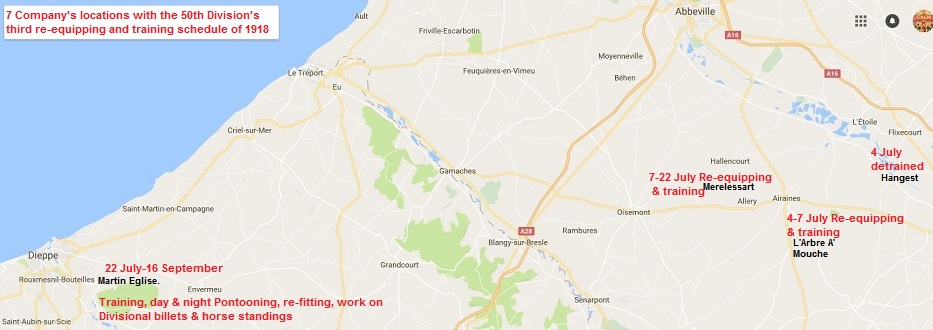
Refitting and training (1st July to 30 September)
By Capt H.A. Baker MC.
The refitting and training of the 50th Division took place near Dieppe, the 7th Company being quartered from 23 july to 16 September at Martin-Eglise where it was brought up to strength, carried out extensive training and worked on divisional camps (hutting, water supply, etc). The training included certain engineer tactical schemes for field companies and the pioneer battalion carried out under the C.R.E, (A.Lieut Colonel P.Hall, M.C., appointed 30 July vice Major J.A.McQueen, D.S.O., M.C. Invalided). On the 2nd July A./Major J. McGill M.C. on appointment as O.C.
Several former NCOs and men rejoined on recovery of wounds and sickness. On the 23rd July, Lt J.B. Glubb, M.C. rejoined on recovery from his severe wound of the previous August. Lieuts T.D.Barratt, W.M. Winstanley, 2nd-Lieut H.G. Stewart joined on the 8th August, 2nd Lieut Seels on the 17th August. On the 16th September the Company proceeded with the reconstituted Division to the 3rd Army area, detraining at Bouquemaison and marching to billets at Brevillers near Agincourt and thence on the 27th to Esbart and on the 29th Epehy. From the 1st October it took part in the advance of the British Armies.
Dieppe
Reinforcements - July 1918
The Company was reinforced
with six officers and 78 other ranks.
L'Ermite
1 July: 9.am: Company marched from L'Ermite to staging area St Loup arriving 1.30 pm and bivouaced for the night.
2 July: 7.am: Company moved from St Loup to Connantray arriving at 12.pm and bivouaced for the night.
3 July: 3.30.am: Company moved from Connantray to Sommesous arriving at 4.45.am sustained at Sommesous at 8.18 am, arrived at Hangest at 10.am 4th July 1918.
4 July: When Coy detrained Company marched from Hangest to L'Arbre A' Mouche arinving at 2.45.pm
L'Abre A'Mouche
5-6 July: Re-equipping and training
7 July: 6.am: Company marched from L'Arbre A'Mouche to new billets at Merelessart arriving at 9.am.
8- July: Re-equipping and training
Merelessart
9-20 July: Re-equipping and training
21 July: Dismounted personnel re-equipping and training. Mounted personnel and transport moved by road Merelessart to Gamaches.
22 July: Dismounted personnel moved by bus Merelessart to Martin Eglise. Mounted personnel and transport Gamaches to Bailey.
Martin Eglise
23 July: Dismounted personnel training and work in Camp. Mounted Section moved Bailey to Martin Eglise.
Martin Eglise
24-31 July: Training and working on 50th Division Camp. Pontooning started 27th & continued each day. Training consisting of close order drill, musketry entended order. Lewis gun instruction, demolition practice, map reading, field geometry, knots and lashings and bridging with pontoon and service trestles.
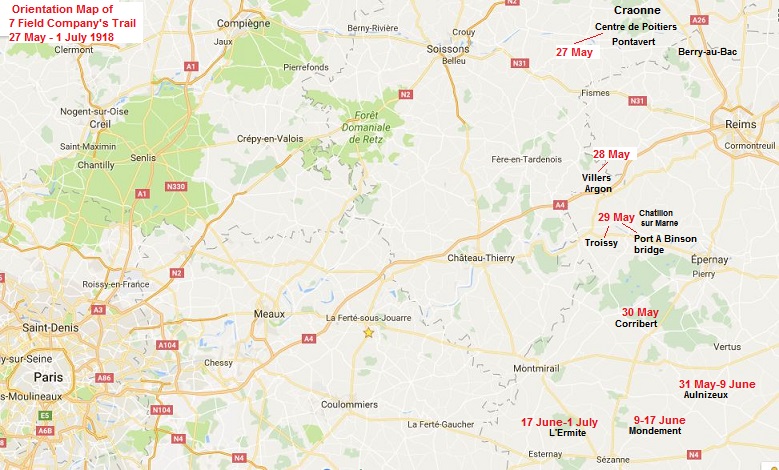
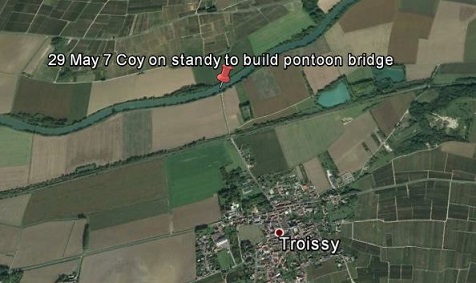
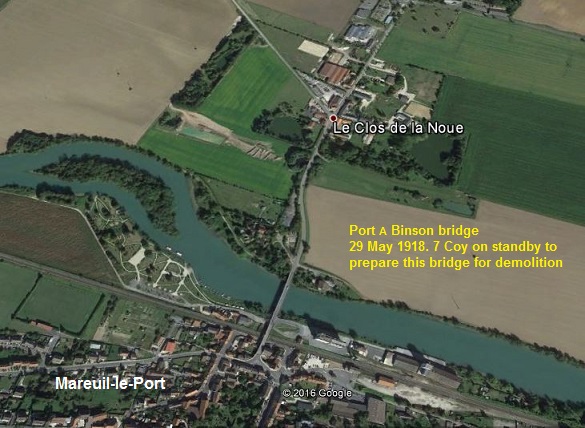
1 June 1918: The Compay was stationed in billets at Aulnizeox and remained there until June 9th, during which time men were being rested and provision made for re-equipping.
2 June: 11 am. C.R.E. conference of O.C Field Companies where instructions were given regarding the formation of a composite Field Company from the 3 dominant Field Coys RE, to be ready to move into the line if ordered. by these arrangements 3 sections with their transport, also portion of HQ transport of 446 N Field Coy RE, and 1 section with transport, and remaining HQ transport to bring the Composite Coy to establishment from 7 Field Coy RE, were to form up as a complete Field Coy RE. For purpose of work this body was named "A" Echelon and will be referred to as such in the following paragraphs. This arrangement necessitated preparations being made for the remaining Divisional RE Transport, not included in the above, and consisting of portions of 446 Northumberland Field Coy, 7 Field Coy and whole transport of 447 Northumberland Field Coy to form a seperate body, this body to be known as "B" Echelon and to be under the command of Capt Duith of 447 Northumberland Field Coy RE.
Arrangements were discussed and it was decided that each respective Field Company in the Division were to remain seperate and intact until such time as orders were received for the 50th Divisional Field Company RE to move into the line, when the Coys would automatically combine and form up into their respective "A" & "B" Echelons.
3-5 june: Company paraded or Physical Training & Drill. vehicles were cleaned. Painting of the same.
6 June: 8 am: The 50th Div Composite Field Coy were paraded for drill under orders of C.R.E
7-8 June: Company paraded for Physical Training, drill. Cleaning and painting of Company vehicles continued.
9 June: 8 am: Company marched into new area Mondement were bivouacs were needed, near a wood 500 yards West of Mondement
10-11 June: Company paraded for Physical Training & Drill. Cleaning and painting of Company vehicles continued.
12 June: 10 am: Inspected by G.O.C. 50 Division of 50th Divisional Field Coy RE at Mondement.
13-15 June: Company paraded for Physical Training, Section Drill & field works.
16 June: Divine Service.
17 June: 9 am: Company moved into new area Les Essarts and new billets in the village of L'Ermite.
18 June: Company paraded for inspection of feet and general fatiques for accommodation of new billets.
19 June: 10 am: "A" Echelon of 50th Divisional Composite Field Coy RE paraded on L'Ermite - La Nove Road for inspection by C.R.E. Inspection was cancelled owing to inclement weather
20 June: 10 am: Inspection by C.R.E. of 50th Divisional Composite Field Coy RE. owing to postponement on previous day.
21-22 June: Company paraded for Physical Training, Section drill. Lectures were given on Trestle Bridges and Demolitions.
23 June: 9 am: Divine Service
2.30 pm. Tug of War competition amongst Divisional Field Coys RE
24 June: 4 pm: "A" Echelon 50th Divisional Composite Field Coy RE paraded for inspection by G.O.C 50th Division
on L'Ermite - La Nove Road but inspection was postponed the last moment.
25 June: Introduction to Sappers in Field Geometery.
26 June: 9 am: Transport of "A" Echelon of 50th Divisional Composite Field Coy RE under 2nd Lt M.King new area.
Jan Villers, preparatory to moving in to line.
27 June: Company paraded for drill and gas drill, inspection of respirators.
Transport of "A" Echelon of 50th Divisional Composite Field Coy under 2nd Lt M.H. King
received orders to return from Janvillers to Company HQ at L'Ermite.
28-29 June: Preparatory training and introduction in Field Works.
30 June: Divine Service
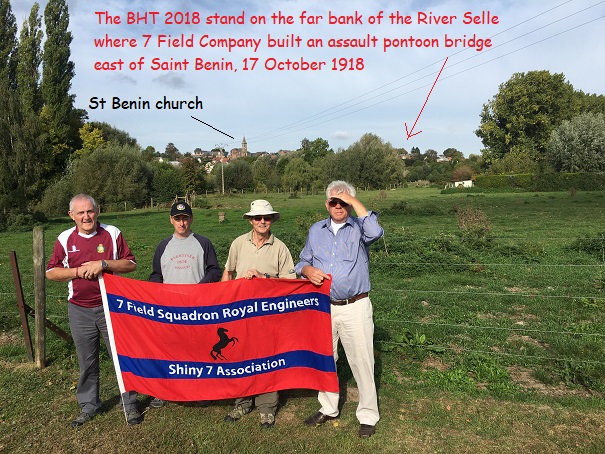
Battle of the 27th May and after
The German artillery had become markedly active from about the 23rd May, registering on batteries, etc. On the afternoon of the 26th information was received at Div.H.Q. of a probable enemy attack in force on the following day. This information having been obtained from a prisoner captured on a raid. The Company received a warning order, together with instructions regarding the occupation of its battle position (a strong point in the reserve line close to the Company’s dugouts at Centre de Poitiers, some 2.˝ miles behind the front line) in the event of the enemy penetrating the front system. This position was reconnoitered on the 26th. At 1.am on the 27 May a heavy bombardment opened, with a high proportion of gas shell, the gas being particularly thick at Div.H.Q., in the artillery positions and in the woods about the reserve line and the Company dugouts. Telephone communication was quickly interrupted. The first cyclist messenger, dispatched to order the Company to proceed to its battle position, arrived too late to be of use, owing to his being gassed and to the enemy’s rapid advance through the woods to the east of the Croanne plateau. The Division was holding a wide frontage. The enemy’s concentrated gas bombardment from 1.am to 5.am had the effect of generally imobilizing the troops holding the line. Despite strenuous resistance, the enemy succeeded in turning the Croanne position and penetrating deeply through the wooded country at an early hour. Heavy fighting and casualties. - The O.C. 7th Company (Major Baldwin, D.C.M.) dispatched an officer Lt Pottle, M.C. to reconnoitre and find out the state of affairs and, on his report, proceeded under heavy shell fire to form up the three sections at the Centre de Poitiers with a view to occupying the pre arranged battle position. Whilst doing so Major Baldwin was killed by shrapnel. The enemy was then found to be advancing through the woods. Confused fighting followed, prior to which Lt Pottle M.C.was wounded whilst engaging the enemy at close quarters, and evacuated. C.S.M Parker, D.C.M. and many others were killed and the sections overwhelmed. Had they been able to reach their battle position they would undoubtedly have proved more effective in holding up the enemy. Amongst those wounded and captured were - A./Capt F.J. Slattery, Lieut H.F.Sharp R.E. No 2 Section at Beaurieux under Lt Rebbeck, M.C. received instructions to retire with the infantry remnants to a position south of the River Aisne at Maisy. This section formed the major part of the Company at the end of the day’s fighting. On the same day the 447th Company (under Major Rainsford-Hannay D.S.O.) was also overwhelmed on the Croanne plateau, after losing heavily from the shell fire concentrated on his commanding position. Owing to the German advance round the eastern side of the plateau, the Company was cut off.
A fine effort of the 446th field Company
This Company (under Major McClellan, M.C.) charged with the demolition of 16 bridges over the River Aisne, gallantly succeeded in destroying 14 of these bridges incurring severe casualties both before and during the work. Theses bridges had all been previously reconnoitered and the necessary charges (French explosives) stored at hand. The fine work of small demolition parties was recognised by the subsequent reward of seven French Croix de Guerre to survivors who signally distinguished themselves. A record of the 7th Company would be incomplete without such reference to the deeds of its sister companies in the 50th Division, with whom, during three years of war. Ties of mutual regard had been formed.
The retreat from the Aisne (27-31 May) and after (1st-30th June
The experience of the neighbouring British and French divisions on the disastrous 27th May were similar. During the succeeding days their remnants retreated steadily, fighting rearguard actions when possible. As the passages, in succession, of the River Vesle, River Ourcq and the River Marne became involved. It was decided not to commit the remnants of the engineers to further infantry action, as their services in connection with possible bridge destruction or construction were considered to be of greater relative importance. Consequently the remains of the 7th Company retired on the 28th May through Cohan, 29th Villers -Argon- Troissy, 30th Igny, 31st Corrobert. During this retirement the Company stood by to prepare for demolition of bridges over the River Camp near Montigny and the suspension bridge over the river Marne at Port-a-Binson (immediately south of Chatillon) but these demolitions were not ordered. It also stood by with the remainder of the divisional engineers to construct a pontoon bridge across the river Marne Troissy, which was not, however, eventually required. On the 28th certain French reserves had came up and by the 30th, the Division was withdrawn from the fight. A single composite infantry brigade was then formed and arrangements made for the the divisional engineers to act as a composite field company if required. The Company remained from the 1st to the 9th June at Aulineux, from the 10th to 17th at Mondement (the scene of heavy fighting in the battle of the Marne 1914), and from the 17th June to 1st July at L’ Hermite. After a short period of action in conjunction with the French and Italian divisions on the outskirts of the wooded Montagne-de-Rheims, the 50th Division Composite Brigade was finally withdrawn on the 1st July for entire re-establishment and refitting. The Division having for the third time in ten weeks (21st March to 30 May) been reduced to less than one third of its fighting strength. The known 7th Company casualties on the 27th May amounted to: 4 officers and 89 other ranks. No record of the relative numbers killed, wounded or missing is available. The following awards were received early in May: Military Cross- Lt H.G. Pottle.Military Medal- A./Serjt J. Bates, A/Cpl S.C. Kelly, A/Lcpl T. Black, Spr W. Atkinson, Spr W. Black.
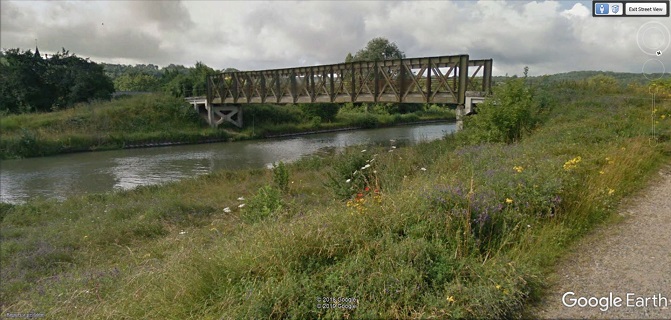
Aisne lateral canal bridge at Convevreux
The map above and the photos on the right are from this excellent book on the Third Battle of the Aisne, available at Pen & Sword books.
ISBN 1783376058
The map left shows the 50th Division's infantry positions on the eve of the attack on the 27 May 1918
German troops in a captured British 50th Division trench on the 27 May 1918




